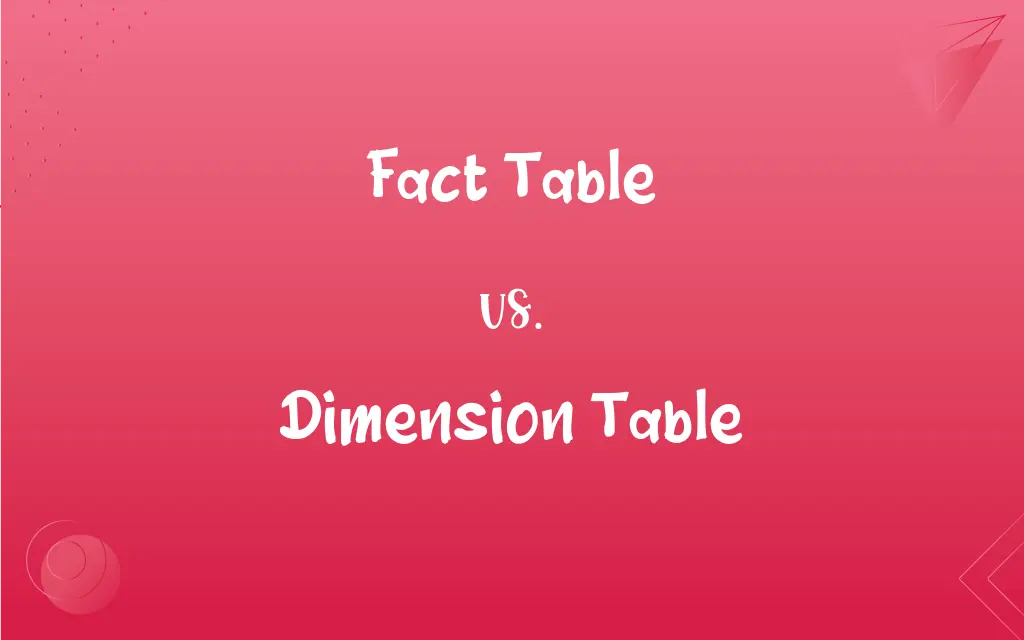Fact Table vs. Dimension Table: What's the Difference?
Edited by Janet White || By Harlon Moss || Updated on October 18, 2023
Fact tables contain measurable data; dimension tables provide context to that data.

Key Differences
In the realm of data warehousing, a fact table serves as the primary table that holds quantitative data. It's the main source for metrics and measures that analytical processes evaluate. Dimension tables, on the other hand, provide the context or perspective for these measurements. They describe the dimensions by which the facts can be viewed or analyzed, such as time, geography, or product categories.
Fact tables are often populated with data that changes frequently and represents performance metrics. For instance, a fact table might contain daily sales figures. Dimension tables, however, usually contain attributes that are relatively static. They give depth and meaning to the raw data in the fact table. For example, a dimension table might list product details, customer profiles, or store locations.
When we think about querying in a data warehouse, the fact table provides the "what" – the actual metrics. The dimension table provides the "how," "when," or "where" – the context. If a fact table tells us how many units were sold, the dimension table tells us which products those units represent, when they were sold, and in which store.
In relational database design, the fact table is typically at the center, surrounded by multiple dimension tables. This star schema design ensures efficient querying. When a user wants to see sales by region, for example, the fact table provides sales data, and the dimension table provides regional context.
Both the fact table and the dimension table are essential for comprehensive data analysis. The fact table offers raw performance metrics, while the dimension table bestows them with clarity and context, ensuring a deeper understanding of the data.
ADVERTISEMENT
Comparison Chart
Primary Content
Contains measurable data
Contains descriptive attributes
Frequency of Change
Changes often (dynamic)
Relatively static
Role in Analysis
Provides the "what" (metrics)
Provides context (how, when, where)
Design in Database
Central in star schema
Surrounds the fact table
Typical Data
Sales figures, transaction amounts
Product details, time frames, location data
ADVERTISEMENT
Fact Table and Dimension Table Definitions
Fact Table
Fact tables are central in star schema designs.
Our database design placed the fact table at the core, linking to various dimensions.
Dimension Table
Dimension tables help interpret raw data from fact tables.
Using the customer dimension table, we could understand which age group bought the most products.
Fact Table
Fact tables represent performance metrics in a data warehouse.
Using the fact table, we could determine the quarterly revenue.
Dimension Table
Dimension tables surround fact tables in star schema designs.
Our database had multiple dimension tables linked to the central fact table.
Fact Table
Fact tables hold quantitative data for analysis.
The fact table showed the total sales for each day.
Dimension Table
Dimension tables contain descriptive attributes about data dimensions.
The product dimension table included information about each product's category, brand, and price.
Fact Table
Fact tables frequently update with new measurements.
Every day, new sales data is added to our fact table.
Dimension Table
Dimension tables are relatively static with infrequent changes.
Once we set up our time dimension table, it rarely needed updates.
Fact Table
Fact tables work in tandem with dimension tables for comprehensive analysis.
The fact table provided sales data, which, when combined with the dimension table, gave us sales per region.
Dimension Table
Dimension tables provide context for fact tables in data analysis.
The dimension table listed all our store locations.
FAQs
What is a fact table?
A fact table stores quantitative information for analysis and is often the central table in a star schema of a data warehouse.
How is a fact table different from a dimension table?
Fact tables contain measures and foreign keys, while dimension tables contain descriptive, textual, or categorical information.
Why are fact tables often large?
They consolidate data from various sources and track multiple metrics over time.
Can a fact table be normalized?
While they can be, they are typically denormalized for performance.
Can a fact table have descriptive data?
Typically, no. Descriptive attributes are placed in dimension tables.
Do fact tables support transactional operations?
No, they are optimized for analytical processing, not transactional operations.
What is a composite key in a fact table?
It's a primary key made up of multiple foreign keys from dimension tables.
Can dimension tables have hierarchies?
Yes, for example, a time dimension might have year, quarter, month, and day.
What is a slowly changing dimension?
It refers to how changes in the data of a dimension are handled, e.g., historical tracking or overwriting.
Do dimension tables typically have fewer rows than fact tables?
Yes, they often have fewer rows since they store unique attributes, not transactional data.
Are dimension tables updated frequently?
No, they are typically stable and updated less frequently than fact tables.
What is a dimension table?
It provides context for data in the fact table by storing descriptive or categorical information.
How do dimension tables relate to fact tables?
Through foreign keys in the fact table that reference primary keys in the dimension tables.
Why are dimension tables denormalized?
To improve query performance and simplify the schema for end-users.
What types of data do fact tables typically contain?
They contain measures (like sales, quantities) and keys to relate to dimension tables.
What is a factless fact table?
It's a fact table without measures, used to track events.
What is a conformed dimension?
It's a dimension that is consistent across multiple fact tables.
What is a junk dimension?
A table that combines multiple low-cardinality flags and attributes.
Why are surrogate keys used in dimension tables?
To provide a stable, system-generated key, unaffected by business changes.
Why are indices important for fact tables?
To enhance query performance due to the large volume of data.
About Author
Written by
Harlon MossHarlon is a seasoned quality moderator and accomplished content writer for Difference Wiki. An alumnus of the prestigious University of California, he earned his degree in Computer Science. Leveraging his academic background, Harlon brings a meticulous and informed perspective to his work, ensuring content accuracy and excellence.
Edited by
Janet WhiteJanet White has been an esteemed writer and blogger for Difference Wiki. Holding a Master's degree in Science and Medical Journalism from the prestigious Boston University, she has consistently demonstrated her expertise and passion for her field. When she's not immersed in her work, Janet relishes her time exercising, delving into a good book, and cherishing moments with friends and family.































































